Power Inverter Buying Guide
Start your search for the perfect power inverter with our overview of the most important features to consider.
This buying guide will help you:
- Understand what an inverter is and recognize its key features
- Understand the difference between an inverter and an inverter/charger
- Know the key questions to ask when selecting an inverter
- Compare the different types of inverters available
- Learn about the important features found on inverters
- Find the right inverter for your application
What is an Inverter?
A power inverter is a device that converts low-voltage DC (direct current) power from a battery to standard household AC (alternating current) power. An Inverter allows you to operate electronics, household appliances, tools and other electrical equipment using the power produced by a car, truck or boat battery or renewable energy source, such as solar panels or wind turbines. An inverter gives you power when you are "off the grid" so you have portable power, whenever and wherever you need it.

What is the difference between an inverter and inverter/charger?
An inverter simply converts DC (battery) power into AC power and then passes it along to connected equipment. An inverter/charger does the same thing, except it is an inverter with batteries attached. It remains connected to an AC power source to continuously charge the attached batteries when AC utility power – also known as shore power – is available.
An inverter/charger is a quiet alternative to gas generators, with no fumes, fuel or noise to deal with. During prolonged outages, you may need to run a generator occasionally to recharge the batteries, but the inverter/charger lets you run the generator less often, conserving fuel.
What is a Power Inverter Used For?
Simply put, a power inverter delivers AC power when there's no outlet available or plugging into one is impractical. This could be in a car, truck, motorhome or boat, at a construction site, in an ambulance or EMS vehicle, at a campground or on a mobile medical cart in a hospital. Inverters or inverter/chargers can provide power for your home during an outage to keep refrigerators, freezers and sump pumps operating. Inverters also play an essential part in renewable energy systems.
DC to AC Conversion: How Inverters Work
The direct current, or DC, power that comes from a battery flows in one direction from the battery's negative terminal, through the completed circuit and back to the positive terminal of the battery. However, typical 12-volt or 24-volt batteries provide only relatively low-voltage power. Depending on your location, appliances need to run on 120-volt or 230-volt AC power.
1.120V Power Inverters
2.230V Power Inverters
An inverter tackles this disparity by increasing the voltage and using transistors or semiconductors to reverse the polarity of the DC input back and forth rapidly, sending it one way through the circuit, then very quickly reversing it and sending it the other way. In most cases, it does this 60 times per second (60 Hz).
Types of Power Inverters
Power Inverters for the Home
If you need emergency home backup power because your home experiences power loss during thunderstorms, hurricanes or severe winter weather, an inverter/charger helps keep essential appliances running.
Most often, emergency home backup power runs off a standard car battery, essentially turning your car into a generator. The car should be kept running while the inverter is in use to prevent the battery from becoming depleted. The inverter can still be used if the car is off, but this is not recommended for prolonged periods. If you do use the inverter without the engine running continuously, start your car up every hour and let it run for 10 minutes to recharge the battery.
To create an emergency backup system without a vehicle, you can hook up two 12V car batteries to one inverter. That will provide enough power to run the average household refrigerator for up to two days, depending on the size of the batteries, the size of the fridge and how full it is. It's a smart idea to have a spare battery or two on hand in case the power failure exceeds your battery runtime.
Look for an inverter or inverter/charger with a wattage capacity greater than the appliances you need to keep running. Refer to Table 2: Typical Wattage of Common Home Appliances below. Ready to buy your inverter/charger now? See our
recommended inverter/chargers for emergency home backup power.
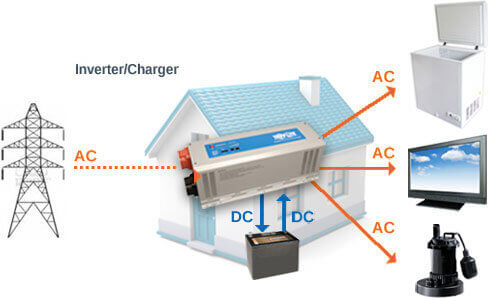
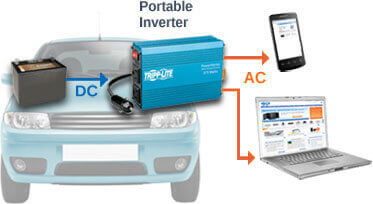
Power Inverters for Cars, SUVs and Vans
The 12V cigarette lighter in a car or truck can be used with a small portable inverter to provide power to charge phones, tablets, laptops, DVD players, light tools and other devices. Portable inverters are an excellent choice for family road trips. These mobile inverters provide one or two AC outlets, plus select models also have two USB charging ports. Tripp Lite's selection of compact portable inverters includes models up to 400W.
Power Inverters for RVs, Trucks & Boats
Don't leave the (electric) comforts of home behind when you're camping, boating or delivering goods over the road. For trucks, boats and recreational vehicles, a permanent-mount inverter/charger hardwired directly to the battery bank lets you run computers, tablets, TVs, coffee makers, blenders and other plug-in necessities.
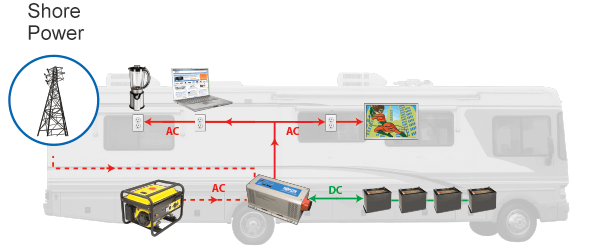
When an AC source like a generator or shore power is available, the inverter/charger passes power to your equipment and simultaneously charges the connected batteries. When disconnected from the power source, the inverter/charger automatically switches to battery power and your electronics and appliances continue to run uninterrupted. See our selection of inverter/chargers designed for RV and marine applications..
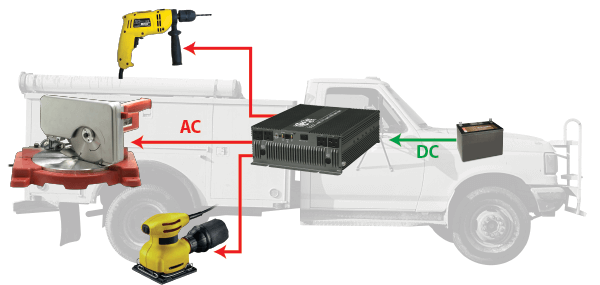
Mobile Power Inverters for Job Sites and Industrial Applications
Inverter/chargers designed for off-grid job sites and work trucks with limited access to shore power use batteries separate from a vehicle's main battery or outside the vehicle entirely. Many power tools, appliances and electronics used in industrial applications require brief bursts of power exceeding their continuous wattage ratings, either at startup, during use or both. Heavy-duty inverter/chargers temporarily provide extra output power to handle these peak surge demands without shutting down. See Tripp Lite's PowerVerter APS Inverter/Chargers.
Power Inverters for Hospital Carts
A medical-grade inverter can retrofit a mobile medical cart for use in a healthcare environment. The mobile power gives the doctor, nurse or technician freedom to bring treatment, monitoring or diagnostic equipment to the patient. Inverters for mobile medical carts should have hospital-grade outlets and be UL 60601-1 compliant. See Tripp Lite's selection of medical-grade inverters for hospital cart power.

Power Inverters for Ambulances/EMS Vehicles
Special medical-grade inverters provide safe and reliable mobile power for critical on-board ambulance/EMS equipment. Inverters used in medical vehicles should be UL 458 compliant. Tripp Lite offers an inverter with an integrated charging system, designed for installation in ambulances/EMS vehicles. See Tripp Lite's Ambulance/EMS Vehicle Inverter.
Power Inverters for Sensitive Electronics
Many devices, such as variable-speed power tools, ATMs, computers with active PFC power supplies, laser printers, networking equipment and audio/video components, require pure sine wave power. Stable, microprocessor-controlled sine wave power enables your equipment to run cooler, last longer and operate without malfunctions or reduced performance caused by substandard power. Tripp Lite features several inverters that provide pure sine wave output.
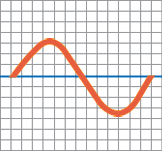
How to Buy a Power Inverter
Power inverters come in different capacities, measured in wattage. Here are 12 key factors to consider when you buy an inverter:
- Inverter or Inverter/Charger – Both inverters and inverter/chargers provide current from stored battery power, but only inverter/chargers connect to AC sources, pass AC through to equipment, recharge batteries and automatically switch to battery power when AC power is unavailable. Inverters that are not inverter/chargers rely on running vehicles to recharge batteries and do not connect directly to AC sources.
- Voltage In – Most commonly, 12V batteries are used to power inverters. This is the type of battery in your car. Heavy-duty inverter/chargers are also available that use 24V, 36V or 48V batteries for applications requiring higher wattages. Ensure the batteries you choose match the inverter's input voltage.
- Voltage Out – In North America, the electric service coming into your home is 120 volt AC power. If you are in North America, ensure your inverter's output is compatible with 120V service to power your electronics, power tools or small appliances.
- Continuous Output Rating – Determine the total wattage required by all connected devices. The continuous output rating of the inverter or inverter/charger must be greater than the wattage of all the equipment that will be powered simultaneously. You can estimate your wattage needed using Table 2: Typical Wattage of Common Home Appliances.
- Input Connection – Small portable inverters plug directly into a vehicle's 12V receptacle (cigarette lighter). Heavy-duty inverters have DC input terminals that connect directly to batteries with user-supplied cabling. Inverter/chargers connect to both batteries and to an AC power source so that the batteries can recharge when shore power is available.
-
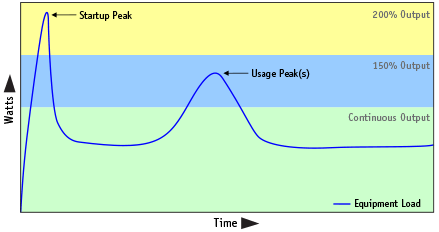 Peak vs. Continuous Power – Many tools, appliances and pumps require brief surges of power when they start up, during use or both. This means temporary wattage is required beyond the continuous power rating of the inverter. Look for an inverter or inverter/charger that can handle such peak power demands by delivering up to 200% of its continuous power rating.
Peak vs. Continuous Power – Many tools, appliances and pumps require brief surges of power when they start up, during use or both. This means temporary wattage is required beyond the continuous power rating of the inverter. Look for an inverter or inverter/charger that can handle such peak power demands by delivering up to 200% of its continuous power rating. - Outlets – Consider how many outlets you will need and whether you need special protection from GFCI outlets for wet or humid environments. Many heavy-duty inverter/chargers can be hardwired into your main electrical panel to provide current directly to your home's AC outlets. For your safety, use a professional electrician for installation.
- Runtime (the amount of time the inverter will provide power for your equipment) – If you're using an inverter connected to the battery in a running vehicle, you'll have power as long as the car keeps running. If your inverter or inverter/charger is running off battery power with no other power source, the runtime depends on the amount of battery power available and the load it is supporting. You can extend your runtime by attaching more batteries. There is no limit to the number of batteries that can be connected.
- Cooling Fans – Multi-speed cooling fans prevent heat buildup and prolong your inverter's service life.
-
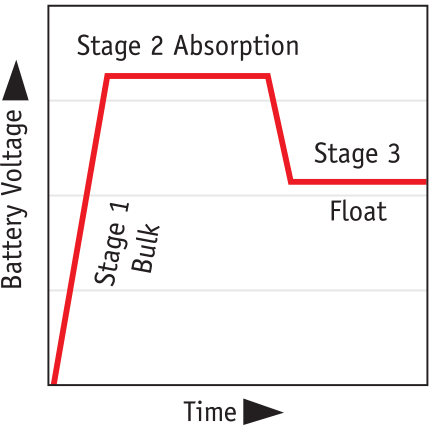 3-Stage Charging - Tripp Lite Inverter/Chargers use an advanced 3-stage charger that recharges batteries faster, while protecting them against over-charge, over-discharge and accidental depletion.
3-Stage Charging - Tripp Lite Inverter/Chargers use an advanced 3-stage charger that recharges batteries faster, while protecting them against over-charge, over-discharge and accidental depletion. - Resettable Circuit Breakers – Protect your inverter/charger against damage from overloads or charger failure.
-
Special Features – When you buy an inverter or inverter/charger, consider if you need any of these special features to power your equipment safely and efficiently:
- USB ports – Easily charge phones, tablets, wearable fitness trackers and other mobile devices.
- Pure sine wave output – For variable-speed power tools and sensitive electronics like computers, network devices and A/V equipment.
- GFCI outlets – Meet OSHA requirements for use in wet or humid environments, including near sinks.
- Hospital-grade outlets – UL certified for use in patient care areas.
- Remote control capability – Some inverter/chargers provide an RJ45 communication port that enables connection of an optional remote control module.
- Status LEDs – Indicate battery levels and low-battery warnings, load levels, overload warnings, system faults and operation modes.
- Configuration DIP switches – Customize high and low voltage auto transfer to suit your application.
- High initial power – Supports peak surge demands of devices with high initial power requirements, such as motors, compressors and pumps.
Frequently Asked Questions
What is the difference between an inverter and an Uninterrupted Power Supply (UPS)?
Inverters and UPS systems both provide power from batteries in the absence of AC power. A UPS typically includes the battery and battery charger in one standalone unit. Batteries for an inverter are generally user-supplied.
A UPS system also can have communication with the equipment that it is powering, letting the equipment know that it is operating on standby, giving it shutdown warnings or communicating with the human in the loop. Inverters typically don't have this capability.
Depending on the inverter, it will respond to a power outage in 4.2 to 16.7 milliseconds. A UPS responds in a fraction of that time, making the UPS a better choice for applications that must remain powered, such as computer networking equipment.
What is the difference between an inverter and a generator?
A generator runs on gasoline, diesel fuel or propane to produce electric power. An inverter converts DC power stored in batteries to AC power needed to run tools, electronics, appliances and other devices.
A generator may be a better choice when large amounts of power are needed for prolonged periods. However, an inverter/charger is a cleaner and greener choice. It is quiet and fume-free, making it preferable for residential areas or for use indoors.
An inverter/charger can work along with generator power when the generator is running, allowing you to turn the generator off for periods of time to save fuel without turning off your equipment.
What is an inverter/charger?
An inverter/charger converts DC (battery) power into AC power and then passes it along to connected equipment. When it is connected to an AC power source, it continuously charges the attached batteries. During a power outage, the inverter/charger will automatically switch to battery power to provide power to connected equipment. The batteries will be recharged when the AC power source becomes available again.
How do I use an inverter for basic home emergency backup power?
Most often, emergency home backup power runs off a standard car battery, essentially turning your car into a generator. The car should be kept running while the inverter is in use to prevent the battery from becoming depleted. The inverter can still be used if the car is off, but this is not recommended for prolonged periods. If you do use the inverter without the engine running, start your car up every hour and let it run for about 10 minutes to recharge the battery.
To create an emergency backup system without a vehicle, you can hook up two 12V car batteries to one inverter. That will provide enough power to run the average household refrigerator for up to two days, depending on the size of the batteries and the size of your fridge. It's a smart idea to have a spare battery or two on hand in case the duration of the power failure exceeds your battery runtime.
Look for an inverter with a wattage capacity greater than the appliances you need to keep running. Refer to Table 2: Typical Wattage of Common Home Appliances below. Ready to buy? See our recommended inverter/chargers for emergency home backup power.
Can I power my home using my car and a power inverter?
Absolutely! First, know the total wattage of the appliances you need to keep running using the guidelines given below . This will help you buy the right inverter for your home emergency backup system.
An inverter is not waterproof, so keep it out of the rain, as well as away from dust and direct sunlight. Although you can connect the inverter to the vehicle's battery using jumper cables and alligator clips, the preferred method is with a ring terminal that fits securely over the inverter post. Then connect an extension cord no more than 200 ft. from the inverter to the appliance(s) you want to run. Beyond this distance, you are likely to experience signal loss.
To keep the battery charged, you should run your car for about 10 minutes every hour. The inverter will still work when the car is off, as long as you have not depleted the battery.
Does an inverter provide surge protection?
Yes. Because an inverter converts DC power to AC power, the AC output is conditioned before it reaches your equipment. The inverter provides stable output voltage and frequency to protect your equipment from power surges and line noise interference, allowing your equipment to perform at its peak.
Can an inverter power a refrigerator or freezer?
Yes, but there is an important point to keep in mind. When a refrigerator or freezer cycles on, it will draw a high start-up surge of power, several times the wattage it requires when running continuously. Make sure your inverter can handle the peak surge. As a rule of thumb, ensure your inverter can handle a peak surge of 500-750W for a refrigerator and 500-1000W for a chest freezer.
What kind of battery should I use with my inverter?
Most commonly, 12V batteries like the one in your car are used to power inverters. Heavy-duty inverter/chargers are available that use 24V, 36V or 48V batteries for applications requiring higher wattages. Make sure the batteries you choose match the input voltage capacity of your inverter.
Deep cycle batteries look like ordinary car batteries, but can provide sustained power over a longer period of time and run reliably until discharged up to 80%. They are ideal for inverter applications, especially in RVs, boats and off-the-grid renewable energy because of their ability to be almost completely discharged before they need to be recharged.
Along with batteries, you'll need a fuse and fuse holder. One of the easiest types of fuses to use is an "ANL" fuse that can be spliced into the positive wire coming from your battery pack.
What type of cable should I use to connect batteries?
Most inverters are sold without cables so the user can select the cable best for their application. In general, the distance between the battery and the inverter should as short as possible, ideally 10 ft. or less. Cables used for connecting inverters should be type SGX, which is the type of cable typically used to connect a battery to a car's electronic system and ground it.
The below recommended wire gauge table is a general rule of thumb. The actual size wire you need will vary based on the voltage of your battery, the total amps your equipment is drawing and the length of the cable. Our best advice is to stick to what is specified in your inverter's owner's manual.
Table 1: Recommend Wire Gauges
| Inverter Continuous Wattage | Recommended Wire Gauge |
|---|---|
| < 500W | 8 AWG |
| 500 - 1000W | 4 AWG |
| 1000 - 1500W | 2 AWG |
| 2000 - 3500W | 1/0 AWG |
| > 3500W | 4/0 AWG |
Is a pure sine wave inverter really important?
Depending on what equipment you're using the answer could be a resounding yes. A pure sine wave inverter produces a smooth, sinusoidal AC output with very low harmonic distortion. Sensitive electronics, variable-speed tools, medical equipment such as oxygen concentrators, TVs and A/V components, fluorescent lights with electronic ballasts and any appliances with microprocessor control will not run well under modified sine wave power.
What size power inverter do I need?

To know the right size inverter for your application, you need to total up the wattage of all the appliances, tools or electronics that will run off the inverter at the same time. Many appliances and power tools have their wattage rating indicated on a label on the product itself or in the item's owner's manual. If your devices indicate only amps, the wattage can be arrived at using this simple formula:
Volts x Amps = Watts
Example: You want to run a small mini fridge. You know from the product label it uses 0.7 amps. In the U.S., voltage is 120. Therefore:
120 x 0.7A = 84 Watts
Now factor in how long you want the device to run. This is its runtime. Assuming you are using 12V batteries, divide the total watts by 12.
In our mini fridge example:
84 ÷ 12 = 7 DC amps
This is the DC amp hours required to run the fridge for 1 hour, if it were to run continuously. You'll need to observe the fridge running for a period of time to determine how long it actively runs, so observe it for 15 minutes and record the length of time it runs.
Let's say you want the fridge to run for 12 hours before the batteries need to be recharged. Your observation shows the fridge runs for 5 minutes during the 15-minute observation period. Use this formula:
Active runtime required = Minutes Running ÷ Minutes Observed x Total Runtime Required
12 Hours = 5 Minutes ÷ 15 Minutes x 4 Hours
Next, multiply the DC amps required by the number of hours you estimate you can operate your fridge without charging the batteries.
7 DC Amps x 4 Hours = 28 Amp-Hours
Now you should factor in an adjustment for variable conditions that might affect how frequently the fridge runs, such as warmer weather, opening the fridge, etc. A good rough estimate is a factor of 1.2.
28 Amp-Hours x 1.2 = 33.6 Amp-Hours
This is the minimum amp-hours your batteries must supply.
How much wattage do common home appliances and tools use?
This table of common appliances, electronics and tools will help you estimate your needs. Be sure to check the product label for the actual wattage requirements, and remember that many tools and appliances have significantly higher peak surge requirements when they start up/cycle on.
Table 2: Typical Wattage of Common Home Appliances
| Device/Appliance | Typical Wattage |
|---|---|
| Desktop Computer with Monitor | 200 - 400W |
| Laptop Computer | 20 - 75W |
| Inkjet Printer | 15 - 75W |
| Laser Printer | 500 - 2000W |
| Satellite Dish | 75W |
| Gaming Console | 125W |
| LCD TV, 32" | 50 - 70W |
| LCD TV, 42" | 90 - 250W |
| DVD Player | 40 - 50W |
| Table Lamp with Incandescent Bulb | 60W |
| Table Lamp with CFL Bulb | 13 - 15W |
| Table Lamp with LED Bulb | 6 - 9W |
| Fluorescent Tube Light | 40W |
| Blender | 300 - 1000W |
| Toaster | 800 - 1500W |
| Coffee Maker, Drip | 550 - 1200W |
| Coffee Maker, Keurig | 200 - 1500W |
| Microwave Oven | 1000 - 2000W |
| Mini Fridge | 350W |
| Refrigerator, 15 cu ft. | 240W |
| Chest Freezer 15 cu ft. | 180 - 500W |
| Vacuum Cleaner | 300 - 1500W |
| Tabletop or Box Fan | 50 - 120W |
| CPAP Machine | 200W |
| Hair Dryer | 1200 - 1600W |
| Flat Iron | 800 - 2000W |
| Sump Pump | 850 - 1200W |
| Space Heater | 1000 - 1500W |
| Furnace Fan | 75 - 400W |
| Electric Drill | 700W |
| Electric Screwdriver | 60 - 300W |
| Circular Saw | 1250W |
| Jig Saw | 350W |
Inverter and Inverter/Charger Installation: Safety Tips
Potentially lethal voltages exist within an inverter/charger whenever the battery supply and/or AC input are connected. First and foremost, carefully follow all safety instructions in the owner's manual or installation guide that came with your inverter/charger and batteries. Inverter installation involves working with live current, so you should have at least basic knowledge of electricity and wiring. If in doubt, hire an experienced electrician. Here are general guidelines to keep in mind:
- Inverters 400W and higher should be hard wired and include the proper fuses.
- An inverter will generate heat. Ensure your installation allows for proper venting and heat dissipation, with at least two inches of clearance on all sides and the top.
- Batteries can generate potentially explosive hydrogen gas that can accumulate near the batteries if they are not well ventilated. The battery compartment should have some ventilation to outside air.
- Don't place your inverter near a heat source, near anything flammable or beneath an area where liquids are used or transferred. Ensure the location will remain free from rain, moisture and dust and is not exposed to direct sunlight.
- When installing an inverter in an RV, connect it to the battery used to power the RV's interior, not the battery that powers the engine.
- Use the proper gauge wire. Refer to Table 1: Recommended Wire Gauges.
- Ground the inverter using its main grounding lug. You can usually do this by fitting the inverter's ground connector around the shank of a bolt in the vehicle's frame. Use the same gauge wire for the ground cable as for the supply cable.
